A Miracle of Human Development in China (1950-2030)
Hu An’gang, Wang Hongchuan
Abstract: China has created an even more spectacular miracle in human development than in economic growth. From 1950 to 2015, China went through three stages of socio-economic development; the “extremely poor era”, the “era of letting some people get rich first” and the “era of common prosperity”, raising its human development to an increasingly higher level. With the world’s fastestgrowing Human Development Index (HDI) during this period, China evolved from a very “l(fā)ow human development level” to a “high human development level”. And it is expected to enter a new stage with a “very high human development level” around 2021. This human development miracle in China indicates that socialism with Chinese characteristics gains strength from being a major country and a late mover, as well as from its development path and socialist system. China, arguably contributing the most to the entirety of human development, can serve as a role model for developing countries and can lead the path for the all-round development of billions of people.
Keywords: economic growth, all-round human development, institutional advantage,China’s experience
As a populous country boasting an ancient civilization, China has created innumerable miracles in human history. Among them the most mindboggling accomplishment is that it has realized the largest-scale population modernization in the world. More than thirty years into the reform and opening-up,China’s economy has experienced continuous high-speed growth, which is acclaimed as the “Chinese economic miracle” by the international community (Lin, Cai, & Li,1999). However, an even more spectacular miracle may have eluded attention — the human development miracle in China.
What is the human development miracle in China and how should it be measured? Where did it start? What was the process? What level is it at now?Where is it going? The human development miracle in China refers to the fact that all the Chinese people, led by the CPC, have maintained high-speed growth of human development indicators for over six decades. China, which had a population of 540 million and a very low level of human development in 1949, has been transformed into a country home to 1.37 billion people with a high-level HDI of 0.727.In the next five to seven years, it is projected to bring 1.4 billion people into a very high level of human development, with an HDI surpassing 0.80.
The miracle of China’s economic growth is part of China’s human development miracle which is supported by the Gross National Income (GNI) per capita (in 2011 USD on a PPP basis), one of the three core measures of HDI. The human development miracle in China, compared with the China’s economic miracle created after the reform and opening-up, spanned a longer period, dating back to the early days of the People’s Republic of China in 1949. Having moved up several notches, it wields a more profound influence on the world. Never in human history has such a large-scale change to people’s lives been accomplished. Nor has there been a bigger miracle in human development in the world’s history.
1. The most important indicator of global modernization: The allround development of people
Marx once noted that the essence of socialism was to promote the all-round development of individuals. According to him, “Man appropriates his comprehensive essence in a comprehensive manner, that is to say, as a whole man” (Marx &Engels, 2009a, p.189). The communist society is a social pattern based on each individual’s all-round and free development (Marx & Engels, 2009b, p.53).Human society has experienced a long and arduous journey to explore how to realize free and all-round human development.
In the 1980s, the Nobel Prize winner for economics, Amartya Sen proposed the “capability approach”, stressing the people’s central place in human development, and laying the ground work for the human development theories.Thanks to Amartya Sen, the UN Development Program (UNDP) proposed the concept of human development for the first time in 1990, and designed HDI that is measurable, quantifiable and comparable.The HDI, measured from three aspects: per capita income, health and education, provided a method of comparing and analyzing different countries in human development. As an indicator, it is more comprehensive than mere per capita income or GDP.So far, 16 Human Development Reports have been released, providing continuous information on HDI.That marks a shift of focus from “object” to “man”,and a great leap forward in human development philosophy.
Modernization of man is the very essence and core of modernization. It is demonstrated by the continuous improvement of human beings’ abilities to develop themselves, or more specifically, the growth of HDI. It took the leading industrialized countries over 200 years to first realize the modernization of man and promote the all-round development of population.①As He Chuanqi (1999) once noted, altogether, human history is to experience two modernizations: for the developed countries, the first modernization lasted about 210 years (1763-1970); the theory of a second modernization, proposed quite recently, holds that the second modernization will last about 130 years(1971-2100).However,the modernization of man only occurred in a few leading industrialized countries. By 1950, those developed countries (including North America,Oceania and Western Europe) altogether had a population of 176 million, accounting for a mere 6.9%of the world’s population at that time (Maddison,2010). It was a population modernization that belonged to a small minority of the global population and a few developed countries. How to realize a large-scale population modernization, especially in developing countries, remained a problem yet to be solved by human society.
Since 1950, there has been a new wave of population modernization in the third-world countries, especially in China. According to the UNDP’s Human Development Report in 2014 and 2015, in 1980, the world’s population was 4.44 billion, and the human development level was medium, with the HDI being 0.559. In 2014, the world’s population rose to 7.26 billion, and the HDI leaped to 0.711, marking the start of high human development. It was in such a global context that China created a human development miracle. Its population grew from 987 million to 1.375 billion,with its HDI rising from 0.423 to 0.727. Thanks to this, the entire human development was able to take a leap forward.
2. The process of human development in China: from extreme poverty to common prosperity
Prior to 1949, China’s Human Development in the global context had stayed at a low level. It not only lagged behind the worldwide average, but also suffered from a much slower growth than the global average. Take life expectancy for example,from 1820 to 1900, the world’s life expectancy at birth raised to 31 years from 26 years, meaning an annual increase of 0.063 years; from 1900 to 1950,the figure rose to 49, with an annual increase of 0.36. By contrast, in 1990, the average Chinese life expectancy was 24 (Maddison, 2001) which was seven years less than the global average; by 1949 the figure lingered at around 35 (National Bureau of Statistics of China, 1999, p.86),①For example, the average life expectancy for men of Nanjing in 1935 was 29.8, and the figure for women was 38.2.with an annual increase of merely 0.22 years, and an increase rate that was only 61.1% of the global average. That was far lower than the world’s average life expectancy,and even lower than its equivalent in France (37 years) and USA (39 years) in 1820 (Maddison, 2001).
From 1950 to 2015, China went through three stages of socio-economic development; the“extremely poor era”, the “era of letting some people get rich first”, and the “era of common prosperity”, raising its human development to an increasingly higher level. As the fastest growing country in human development, China has realized a transformation from “a very low human development level” to “a high human development level.”②UNDP reports divide human development into four stages: low human development (0-0.550), medium human development (0.551-0.700), high human development (0.701-0.800), and very high human development (0.801 and above). See also UNDP: Human Development Report 2015. For a better comparison,here the low human development is further divided and human development that falls between 0-0.400 in HDI is defined as a very low human development.This is called the “human development miracle in China” (Table 1).
The first stage is the extremely poor era (1949-1978). The year 1950 saw China’s HDI hitting the world’s lowest level of merely 0.145, which was even lower than that of India (0.167). China’s per capita GNI then was only USD 172, also lower than India’s per capita GDP (USD 836), accounting for a mere 21.2% of the world’s average and remaining at a very low level of income in the world. China’s health care also suffered a very low level. In some remote rural areas and regions inhabited by ethnic minorities, the infant-mortality rate generally surpassed 200‰, and
the maternal mortality rate was 15 per ten million(National Bureau of Statistics of China, 1999, p.86). Worse still, China was afflicted with rampant infectious and parasitic diseases as well as a high incidence of endemic diseases. Before 1949 the tuberculosis mortality rate was 2.5%, and in the 1950s the reported incidence of national infectious diseases was as high as 30%; before 1949, the mortality rate of China reached 25‰-33‰ making it a typical country with a high mortality rate. The education sector of China also lagged far behind,characterized by an overwhelming illiteracy rate and a very low level of development. Over 80% of the Chinese population were illiterate (Zhao, 2009,August 27) and the net enrollment rate of schoolage children was merely 9.2%. In 1949, the number of students in Chinese institutions of higher learning was 126,000, the number in secondary schools was 1.268 million, and the number in primary schools was 24.39 million. The number of all the students studying on campus fell short of 5% of the total population. The average schooling years for those above 15 years old was only one year which was basically equal to its Indian equivalent (0.99) and far lower than its US equivalent (8.4). Overall, the early years of the Republic of China were indeed destitute,featuring very low level of income, well-being and educational development.
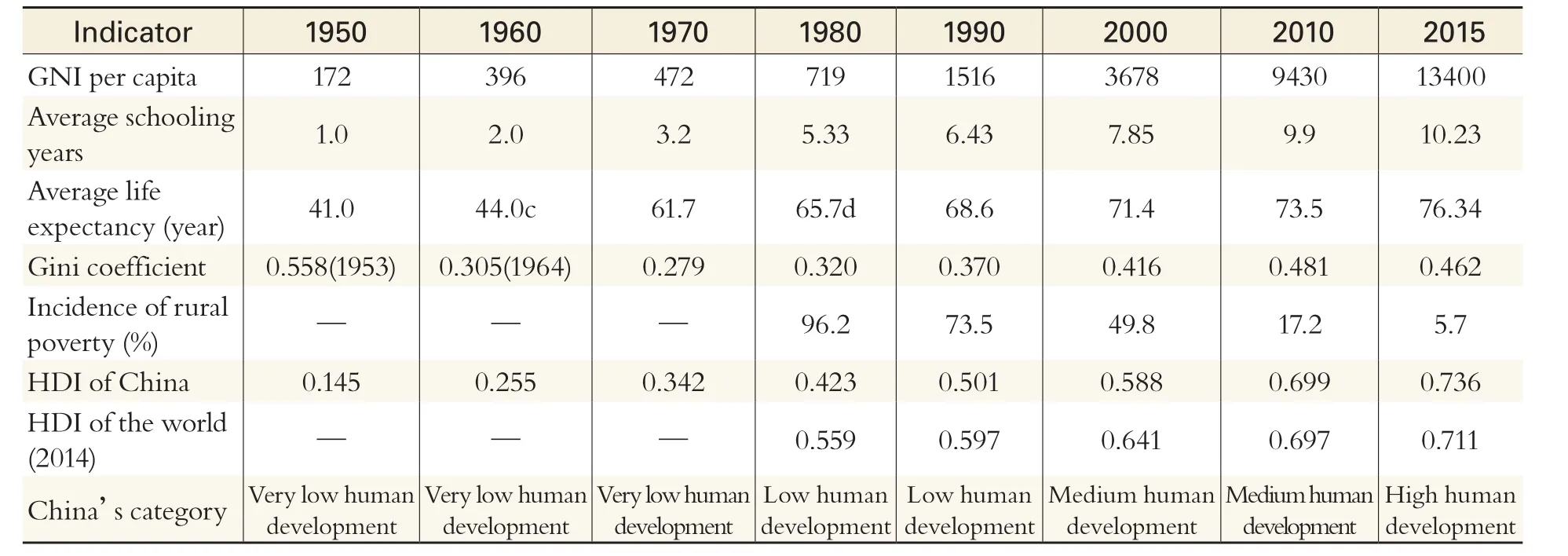
Table 1 Progress of Chinese Socio-Economic Development and China’s Human Development (1950-2015)
The biggest challenge to improvement, before the Republic of China could shake off poverty was the extreme shortage of resources. To that end, the government launched the socialist transformation. It established the planned economy system based on public ownership which has restarted and boosted economic growth. Even though there were severe setbacks, the actual GDP per capita still witnessed a 4.05% growth from 1952 to 1978 (National Bureau of Statistics of China, 2010, p.12). The government,focusing on improving living standards, established a primary health care system that emphasized community-level health care and disease prevention and targeted epidemics posing serious threats to people’s health and those diseases jeopardizing the lives of mothers and their infants. A nationwide campaign was also launched to dispel illiteracy and promote basic education, building a low-level wide-ranging basic service system. The average life expectancy was raised from 41.0 in 1950 to 65.7 in 1980, an annual increase of 0.82 years, surpassing the world’s average and marking the fastest increase in history. The average schooling age increased from 1.0 year to 5.33 years, a cumulative increase of 4.33 years and an annual increase of 0.14 years.During this stage, against the relatively low-income level, China realized fast development in education and health care, whose development indicators also saw drastically reduced gaps between different regions and between urban and rural areas. Income inequality was reduced, and the Gini coefficient,before rising to 0.320 in 1980, experienced a plunge from 0.558 in 1953 to 0.266 in 1975.①M(fèi)ilanovic’s Gini coefficient database ALG (2014 autumn edition) that covered 166 countries from 1950 to 2012.Chinese HDI raised to 0.423, marking China’s transformation from very low human development to low human development. The basic scenario then was that China was still the largest country that was struggling with absolute poverty. By 1978, according to rural absolute poverty standards, there were still about 250 million poverty-stricken people in China’s rural areas, the incidence of poverty being 30.7%. By the standards in 2010, the rural poor population would have then been 770 million and the incidence of poverty as high as 97.5%. China was still a destitute country. Thus, the primary task of the reform and opening-up that followed would be the large-scale eradication of poverty.
The second stage: the era of letting some people get rich first (1978-2000). The early days of the reform and opening-up witnessed the Chinese HDI reaching 0.423, outpacing its Indian counterpart. The progress mainly originated from the improvement of the wellbeing of people and the development of education. In terms of per capita income, China was still at a very low level. In 1980,Chinese GDP per capita was merely USD 719 (in 2011 USD on a PPP basis), which only accounted for 22.1% of the word’s average. Chinese leaders intended to achieve substantive results, and in 1980 Deng Xiaoping proposed the strategic goal of reaching moderate prosperity by 2000. The year 2000 saw Chinese HDI reach 0.588, meaning a 0.165 increase during the 22 years, and a step closer to the world’s average level. Chinese GNI per capita was raised to USD 3678 (in 2011 USD on a PPP basis),an annual increase rate of 8.50% between 1980 and 2000, marking the fastest increase in history. The average schooling years increased from 5.33 in 1980 to 7.85 in 2000, an average increase of 0.126 per year. The life expectancy was elevated from 65.7 years to 71.4 years, an average increase of 0.29 per year, which was obviously lower than the average annual increase of 0.82 between 1950 and 1980(Jiang, 2006, pp. 528-575). The income gap between residents was further widened. The Gini coefficient surpassed 0.4 in the 1990s and the policies for social development were relatively backward. Meanwhile,poverty reduction endeavors were richly rewarded.Measured by 2010 poverty standards, the rural poor population dropped from 770 million in 1978 to 287 million in 2000, a decrease of 483 million. The incidence of rural poverty plunged from 97.5% to 49.8%, a 47.7% decrease with an average decrease of 2.17% per year. Half of the rural povertystricken population were relieved from poverty during these 22 years. The economy also witnessed fast development, contributing more to HDI than education and health care (UNDP & Development Research Center of the State Council of China, 2016,p.141), and Chinese human development realized a transformation from “l(fā)ow human development”to “medium human development”. As the report of the 16th National Congress of the CPC noted, living standards overall had reached moderate prosperity,but it also had to be understood that this prosperity was still at a low level, incomplete and unbalanced(Jiang, 2006, pp. 528-575).
The third stage: the era of common prosperity(2000-2030). Into the 21st Century, the report of the 16th National Congress of the CPC explicitly proposed that the first 20 years of the new century must focus on building a higher-level moderately prosperous society in all aspects that was to benefit billions of people. This marked China’s transition from the era of letting some people get rich first to the era of common prosperity. During this period China’s Human Development has made new breakthroughs. In 2011, Chinese HDI reached 0.707 bringing the country into the high human development group (HDI above 0.70). In 2015, the HDI further raised to 0.736. The GNI per capita reached USD 13400 (in 2011 USD on a PPP basis),and the annual increase rate on average from 2000 to 2015 was 9.0% marking a period of high-speed growth. Due to the prominent contradictions arising in the socio-economic transition, the Chinese government invested more in the public sector,such as health care, education and social security,improved public services, rapidly built a basic public service network and made notable achievements in enhancing living standards. In less than ten years,the coverage of basic health care reached 95%. The average life expectancy rose from 71.4 in 2000 to 76.34 in 2015, an annual increase of 0.33 on average,managing high growth due to the high level of health. Average schooling year increased from 7.85 years in 2000 to 10.23 years in 2015, an annual increase of 0.16 on average. The Gini coefficient indicating the income gap between residents peaked in 2008 (at 0.491), then gradually descended to 0.462 by 2015. The income gap between urban and rural residents, after reaching an apex in 2009 (3.33 times), began to dwindle, and sank to 2.73 times by 2015. Measured by 2010 poverty standard, rural poor population was reduced from 287 million in 2000 to 55.75 million in 2015, a decrease of 406.49 million.The incidence of rural poverty dropped from 49.8%to 5.7%, a 44.1% decrease (National Bureau of Statistics of China, 2016, p.70). By 2020 poverty will be eradicated (according to 2010 poverty standards).It is estimated that sometime around 2021 Chinese HDI will surpass 0.800 and China will enter the very high human development club. By 2030 Chinese HDI will reach 0.861 and China’s membership in this club will be secured. At this stage, economic growth and social development will be better balanced. Despite a possible decrease in the growth rate of GNI per capita, education and health care will wield a larger influence than economic growth and contribute to the continuously fast growth of Chinese HDI (UNDP & Development Research Center of the State Council of China,2016, p.148).On the whole, this stage will see China move up two steps, rising from medium human development to high human development, and then further up to very high human development.
The world HDI rankings reveal that China has,over the past 30 years, been the fastest ascending country in the ranking table (Table 2). In 1980, China ranked 92nd among 124 countries, merely making its way among the top 74.19%. By 2014, China had moved up to 90th among 188 countries, and was listed in the top 47.87%, increasing 26.32% compared with 1980. The average rate of moving ahead 1.10%per year also outpaced its Indian equivalent. The ratio of Chinese HDI to US HDI, or “the chasing index”as we define it, leaped from 51.3% in 1980 to 79.5%in 2014 (see Annexed Table 1), increased 28.2%, an annual increase of 2.01% on average.
It is known that China took over 60 years to transit from very low human development to low,medium and finally high human development, and blazed a trail for human development with Chinese characteristics. This very trail was made up of twoconcrete paths; the path of economic development from “a very low-income country” to “a mediumand-high-income country”, the path of educational development from “being full of illiterates”, “severe shortage of talents” to “a country powerful in human resources” (Hu, Wang & Yan, 2015, pp. 9-14). And that explains the most basic source of the human development miracle in China.
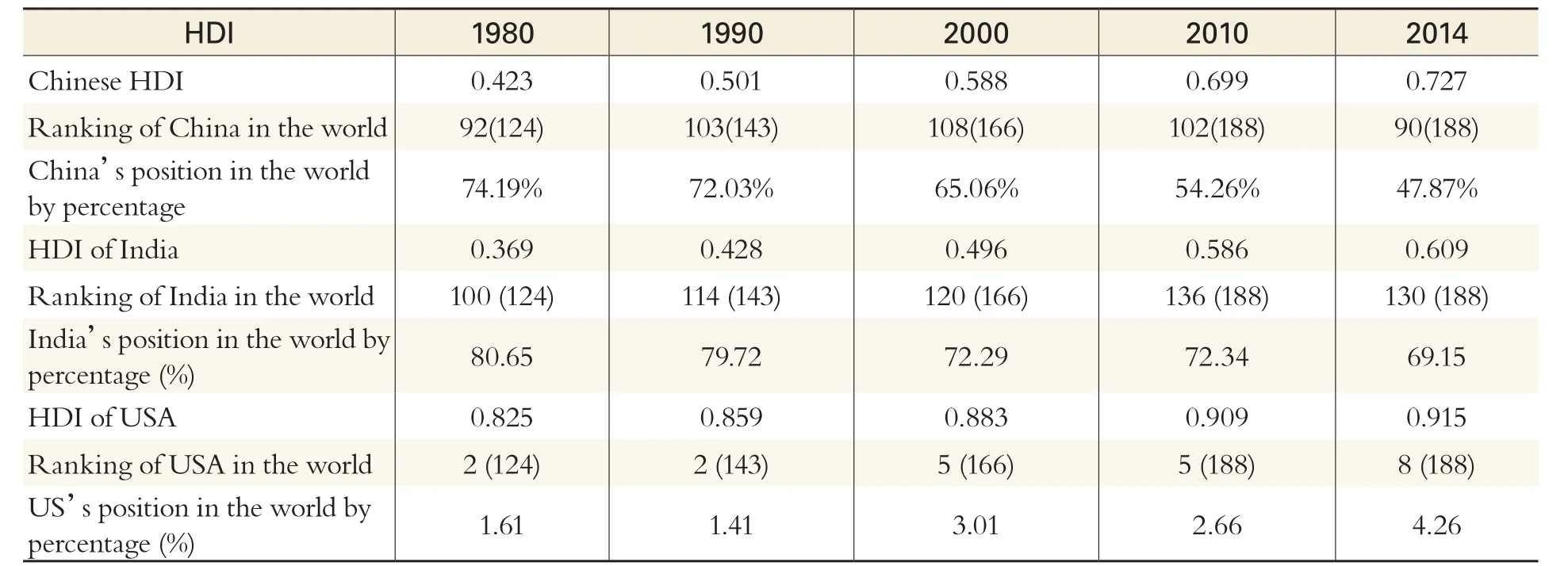
Table 2 HDI World Ranking Changes to China, India and USA (1980-2014)
3. The human development miracle in China and its four advantages
The human development miracle in China was not achieved by accident. It went through a process from extreme poverty to partial prosperity and then to common prosperity that spanned more than 60 years. It first witnessed a quantitative change,then a partial qualitative change, and finally a complete qualitative change, as well as a new trail of human development with Chinese characteristics.Basically, this was decided by the socialist nature of investors, the socialist goal of enforcing and expanding people’s freedom, and the CPC’s fundamental purpose of wholeheartedly serving people. The success of Chinese human development should be attributed to both internal and external reasons, both necessary and sufficient conditions,and both objective and subjective advantages.We can attribute the successful China’s Human Development to four advantages that socialism with Chinese characteristics possesses.
Major country’s advantage is the objective condition of the human development miracle in China. With its huge population, China boasted great potential in human development and was able to cause a large spillover effect. The social construction during the extremely poor era helped reserve capable labor forces, provided a preliminary demographic dividend for the reform and openingup and advanced economic growth. During the reform and opening-up, the improvements in health and education unleashed a huge human capital dividend, which will be proved an impetus for the continuous medium-and-high-speed economic growth during the new normal period. Meanwhile,it also must be realized that, though China has entered the high human development group, it is still challenged by unbalanced development between urban and rural areas, between different regions and different groups, due to its huge population,broad territory and largely different local conditions.Though there is a trend to converge across regions in human development, future human development must still focus on better coordination between economic development and social development,finding a balance between different regions and resolving the problem of inequality” (Hu, Wang &Wei, 2013, pp. 55-68).
The late-mover advantage is international context of China’s development miracle. With a low base, a weak background and poor conditions, China had everything that made it a late-mover. But it insisted on learning from international experiences. Since the reform and opening-up, China was benefited by the globalized environment and contributed its due portion to the world’s human development. It was able to draw on the successful experiences of other countries, learn from their mistakes, and catch up, making its time for modernization shorter than that of the developed countries, and race into high human development. It must be clarified though,that being a late-mover is the common advantage of the developing countries. However, there is no other late-coming developing country except China that could so instantly and drastically raise its human development level. And why was that? We hold that external causes were a condition, yet internal causes were the basis that counted the most. The answer to China’s human development miracle can be found in its internal mechanism.
The path advantage is the inner cause of China’s human development miracle. This very path was in fact the modernization of man, which focuses on people throughout its course, and aims to improve living standards and raise the level of human development. The Chinese socialist modernization is in its nature a modernization of man. The Chinese human development spanning over 60 years consists of three paths; economic development, educational development and the health care development.During the period of planned economy, despite the severe shortage of resources and the lack of an economic base, China managed to build a primary basic service and security system that covered a wide range of the population and laid the human capital foundation. During the reform and openingup, the huge demographic dividends boosted China’s economic growth and brought a continuous highspeed growth of material wealth that lasted 30 years.This process did not go without mistakes though.China used to be in lopsided pursuit of economic growth and ended up with “one leg shorter than the other”, its social development lagging far behind. In the 21st century, the government changed its focus,and made new efforts to build the social protection system and coordinate economic growth with social development. As incomes increased steadily, the health of people was continuously improved, and education made increasing progress. The three factors altogether were to elevate China’s Human Development to a higher level. China blazed a new trail that was more suitable for its national conditions and more effective in coordinating economic growth with social development. This was a road of human development that proved faster, smoother and more intensive than that of the developed countries. The comparison between China and the USA reveals that in 1950,Chinese GDP per capita only equaled 1.1% that of the USA, while its average life expectancy was only 60.1%that of the USA, average schooling years only 11.9%and HDI only 21.3%. Over 60 years on, despite a far lower GDP per capita than the USA, China managed to catch up with the USA in human capital factors like health and education. By 2010, though China’s GDP per capita was only one fifth that of the USA, its average life expectancy had achieved 95.3% of its USA counterpart, average schooling years 75.6% and HDI 76.9%. It is estimated that by 2030, when China’s per capita income reaches half of its USA counterpart, its average life expectancy will arrive at 98% that of the USA, average schooling years 90% and HDI 92.6%(Chart 1). It took China a relatively short period (1950-2030) to achieve what the USA attained over 200 years of modernization. That indicates the superiority of the Chinese path. What’s worth pointing out is that this very path is also one of resource-intensive development. Through the lens of health care, China,as the largest developing country, was challenged by a tiny number of public health care resources per capita.In 2014, China was home to 18.79% of the world’s population, yet its health care expenditures only accounted for 7.4% of the entire world. It was with those scarce health care resources that China managed to improve the well-being of its people. In contrast, the US’s health care expenditure assumed 38.28% of the world’s total, while only accommodating 4.39% of the world’s population (Table 3).①According to the report of U.S. Census Bureau, during 2008-2013, the percentage of people without health insurance coverage was slightly changed, before it notably fell in 2014, with a 2.9% decrease from 2013. In 2008, 14.8% of US population were without health insurance; in 2013, the figure dropped to 13.3%,meaning 41.8 million people uncovered by any form of health insurance; in 2014, 10.4% US people lived without any form of health insurance, and the number of uncovered people decreased by 8.82 million to 32.97 million. Despite a mere 2.9% drop, that was a huge change given the US health insurance coverage in the recent decades. Thus it was viewed by US government as important achievements of the Obama Health Care Plan (United States Census Bureau, Health Insurance Coverage in the United States: 2014,2015.(9).
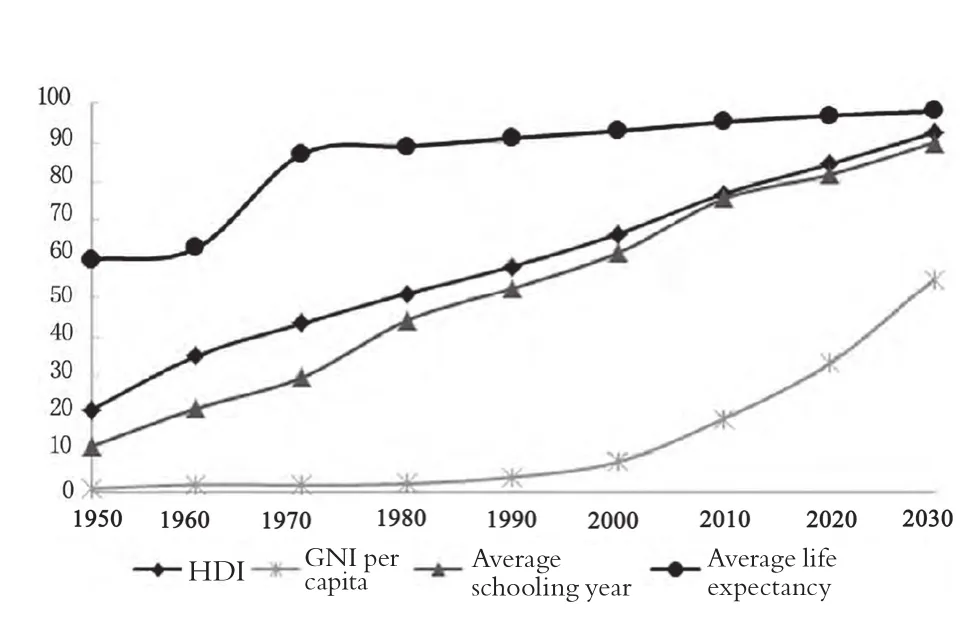
Chart 1 Chasing Index of China to the USA (1950-2030)Note: The figures of the calculation are from the Annexed Table 1.
Institutional advantage was the fundamental impetus for the human development miracle in China. Here is a comparison between China and India in human development. As the two most populous countries, both were among the most energetic and potential economies of the developing countries, and both had realized a large increase in HDI. In 1950, China’s HDI was lower than and accounted for 86.8% of its Indian counterpart. In 1980, with a lower GNI per capita, China saw its expected schooling years, average schooling years and average life expectancy surpass those of India.Chinese HDI outpaced and reached 1.15 times that of India. In 2000, China exceeded India in indicators of income, education and well-being, and Chinese HDI was 1.19 times its Indian counterpart. By 2015,Chinese HDI was obviously in the lead and reached 1.21 times the Indian HDI. China exceeded India in many development indicators, among which the HDI that well represented socialist factors saw the most marked progress. Chinese life expectancy outpaced Indian life expectancy by nearly 8 years,and its average schooling years by 4 years (Table 4).In terms of health and education indicators, China was at least 20 to 30 years ahead of India. At its current pace, India would have to wait until around 2040 to achieve what China has attained at present.That fully exhibits the “institutional advantage” of socialism with Chinese characteristics. So, what is institutional advantage? First, it means an ability to focus efforts on great undertakings. What is a great undertaking? It refers to incessant investments of human capital in the people, especially the investments in their health, which is fundamental and effective for the long run, and is sure to yield long-term rewards and dividends, namely health dividends and education dividends. Second, the“two hands”—government and market—could be fully leveraged. The government could take charge of planning and macro-control, and the market could have a chance to give full play to its energy.Third, people could be organized and mobilized.In the extremely poor era, despite having very few resources, China was able to break out of the “trap ofpoverty” and provided basic guarantee for education and health care by means of widely involving the people. In addition, China’s institutional advantage can also be found in its political advantage, and advantages of democratic and scientific decisionmaking, which was represented by the “Healthy China 2030” Planning Outline and the process of making “Educational Modernization” a policy.①On May 27, 2016, National Health and Family Planning Commission of China solicited public opinion through its website on the planning outline. This process indicated public involvement and democracy in decision-making. Retrieved from http://www.nhfpc.gov.cn/.

Table 3 Comparison of China and the USA in the World Health Care Resources (1995-2014)Unit:%
The advantages China gained from its role as a major country and a late mover, as well as from its development path and socialist system,were not gathered for a simple addition, but by a multiplication. As a late- mover, China did not copy the development path and experience of the developed countries. Instead, it carefully handled the relationships between the four advantages based on its institutional and political strengths as a socialist country, fully leveraged the four advantages and maximized their influence as much as possible. That is the fundamental source of the success of China’s human development, and it will go on leading China onto a more successful path in the future while itstrives to keep pace with the developed countries in human development.
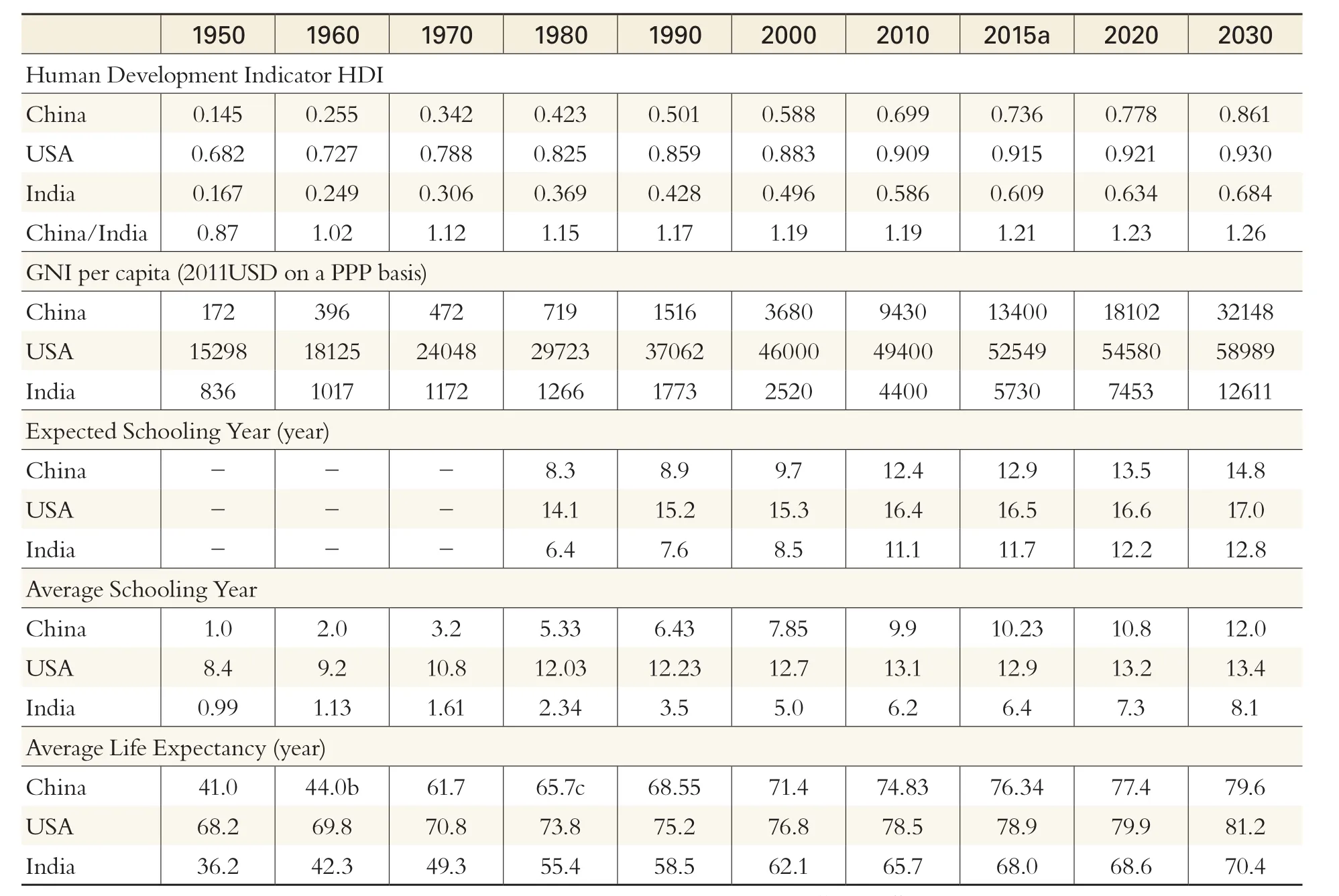
Table 4 Comparison of Human Development Among China, the USA and India (1950-2030)
4. Conclusion: China is a significant contributor to global human development.
Since the Industrial Revolution, there has been no modernization of man occurring in countries as large as China. The developed countries in Europe and America has a population less than half of the Chinese population, and it took over 200 years for them to realize the modernization of man, while China barely used half of that time to achieve that goal.
President Xi Jinping (2016) pointed out that“China will continue to contribute to global development.” And China indeed has contributed much to the world’s human development. According to the UNDP Human Development Report 2015, in 2014 the population of the high human development group was 2.5167 billion, including the Chinese population of 1.37 billion, which accounted for 54%of the total population. Based on this tendency, it can be estimated that by 2030 the total population of the very high human development group will increase to 1.266 billion from 1.185 billion in 2014 and that China’s successful entering into the very high human development group will add 1.45 billion people to this group. This means pushing the population of the very high human development group up to 2.716 billion, accounting for 32.2% of the world’s future population. In fact, currently several regions in China have already achieved the very high human development level, such as Beijing, Shanghai and Tianjin, involving 61.33 million people, almost equal to the population of the UK. The Chinese miracle is not only represented by its fast-growing economy which has made huge contributions to global economic growth, but also is displayed by the rapid progress of China’s human development, which has made China the biggest contributor to the world’s human development.
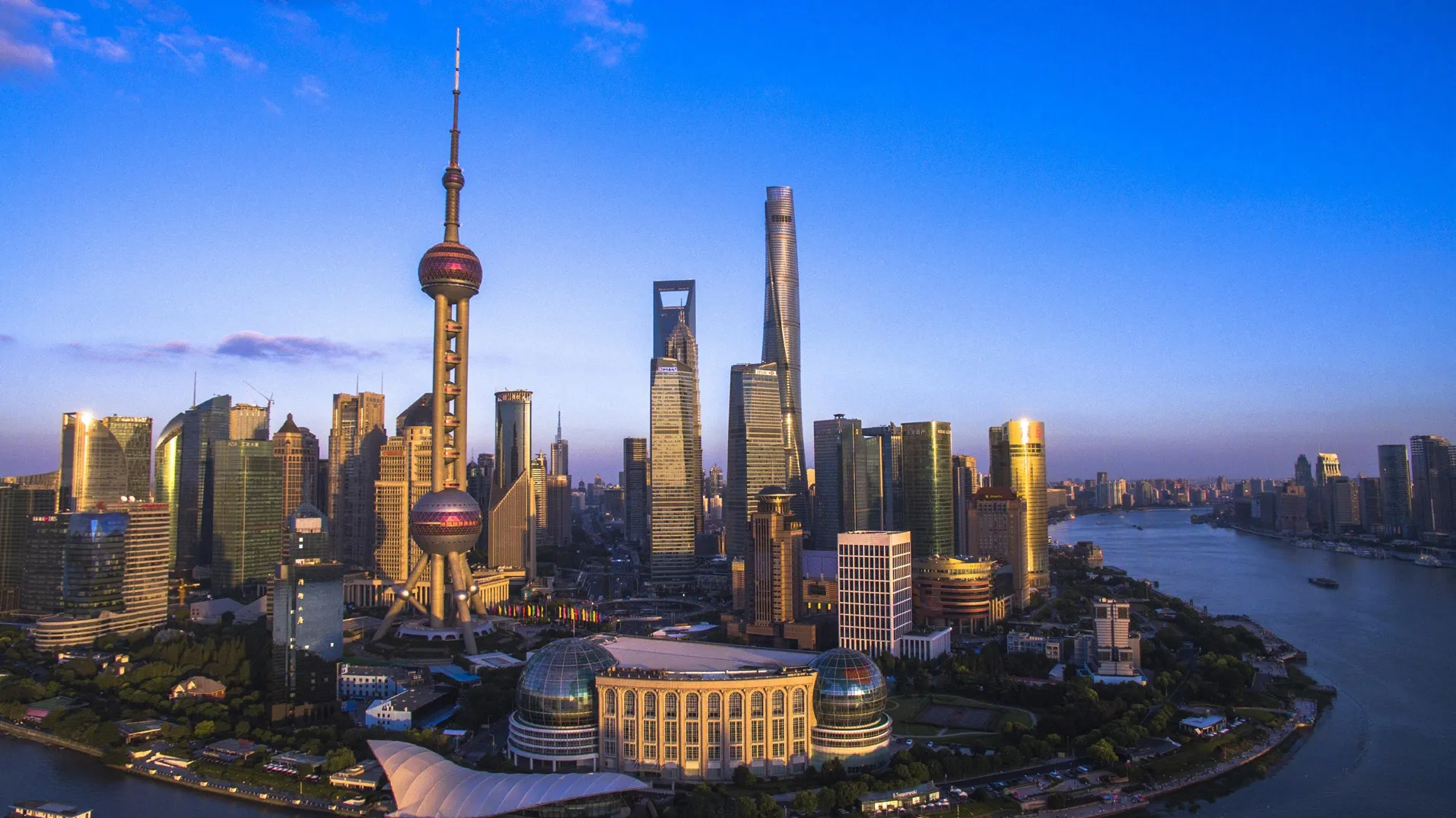
Currently several regions in China have already achieved the very high human development level.
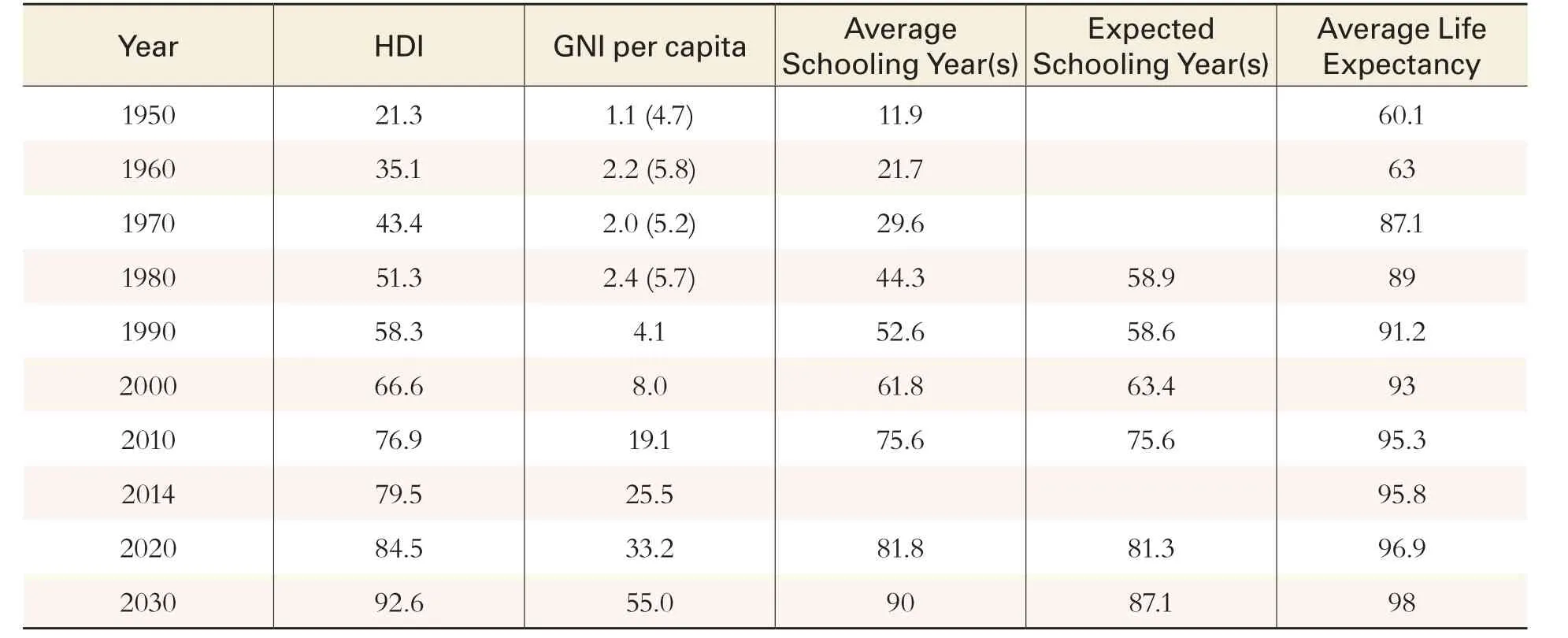
Annexed Table 1 The Chasing Index of China to USA (1950-2030)Unit: USA=100%
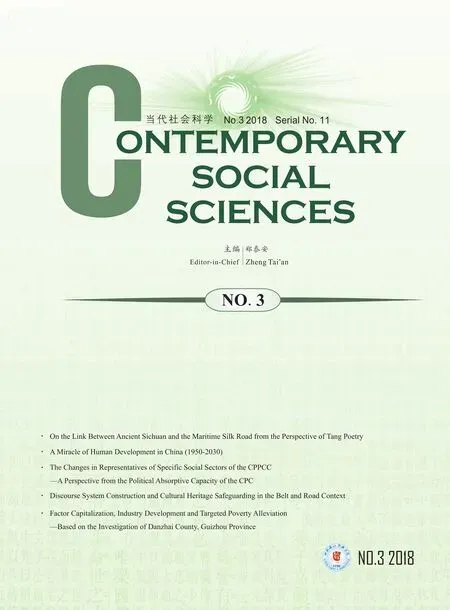 Contemporary Social Sciences2018年3期
Contemporary Social Sciences2018年3期
- Contemporary Social Sciences的其它文章
- The Placement of “Nostalgia” and Protection of Folk Culture in the Context of Urbanization
- The Changes in Representatives of Specific Social Sectors of the CPPCC—A Perspective from the Political Absorptive Capacity of the CPC
- Phased Analysis of the Evolution of the Ecological Civilization Concept—A Historical Review from a Global Perspective
- Digital Preservation: A New Approach to Protecting Historical and Cultural Towns and Villages
- Population Quality-based Demographic Dividend, Industrial Transformation and Sustainable Development of the Chinese Economy and Society
- New Approaches to Targeted Poverty Alleviation in the Age of Big Data—On Improving the Results of Targeted Poverty Alleviation Programs (10)
